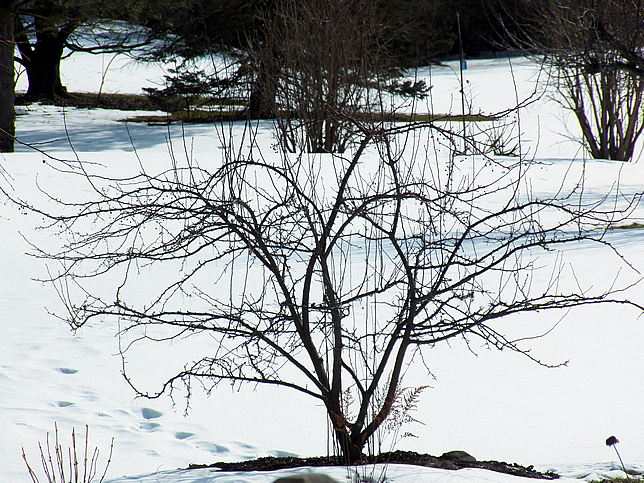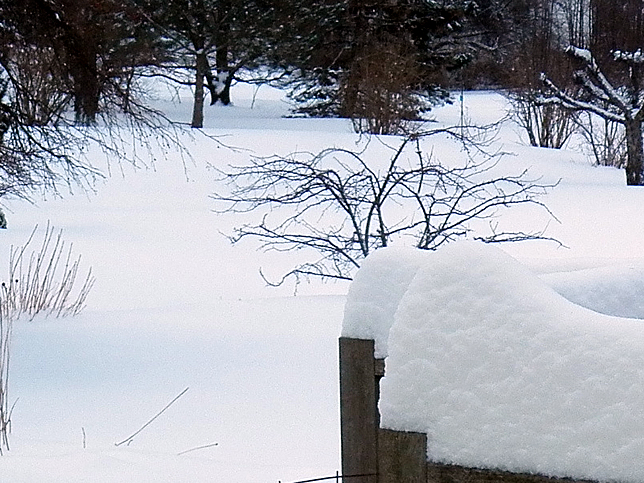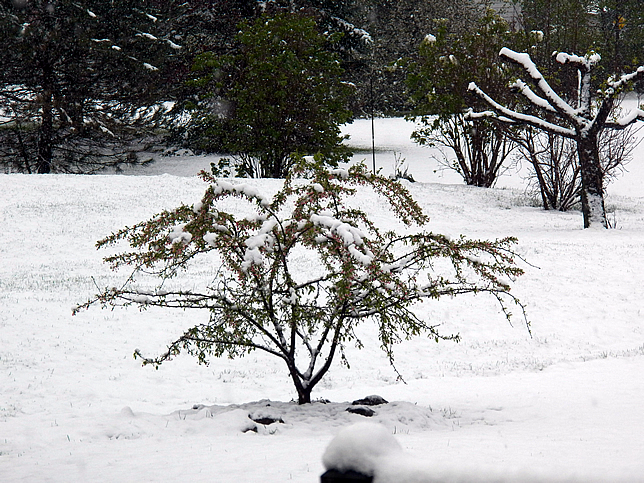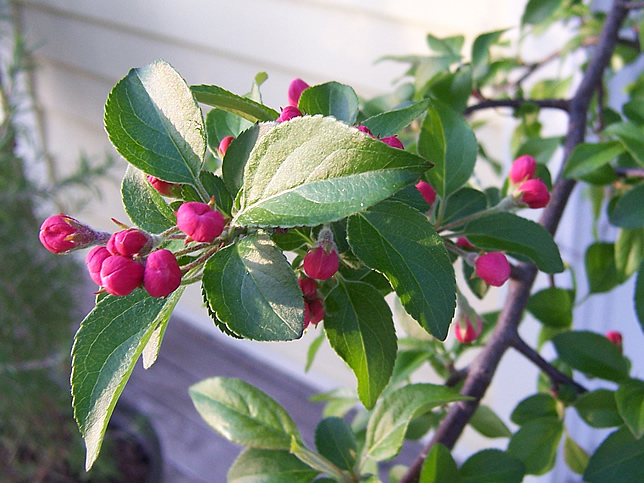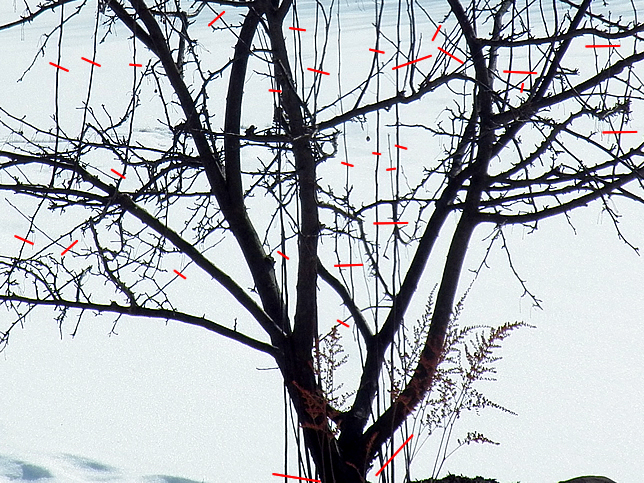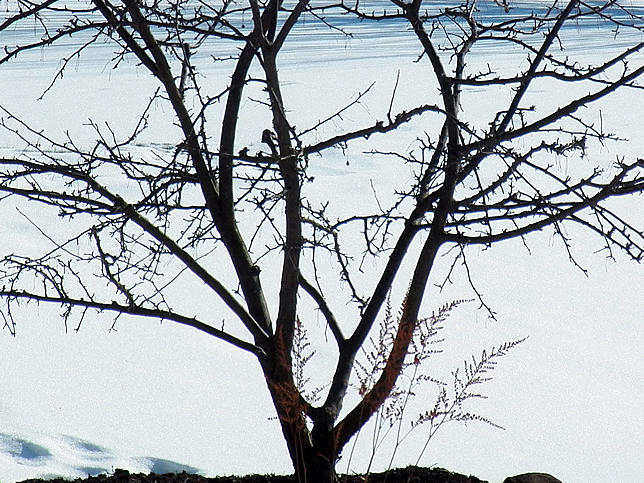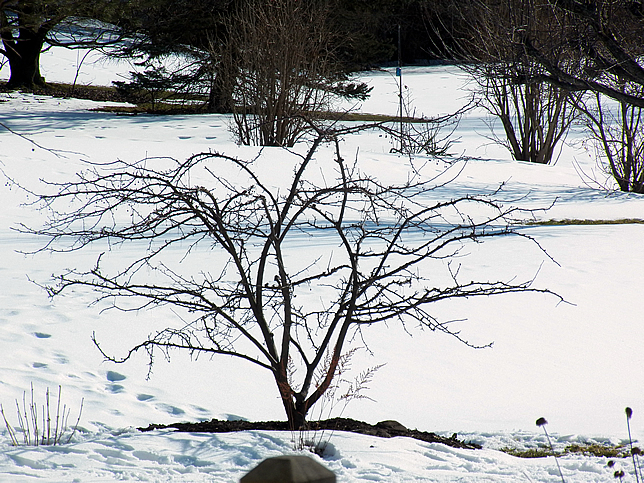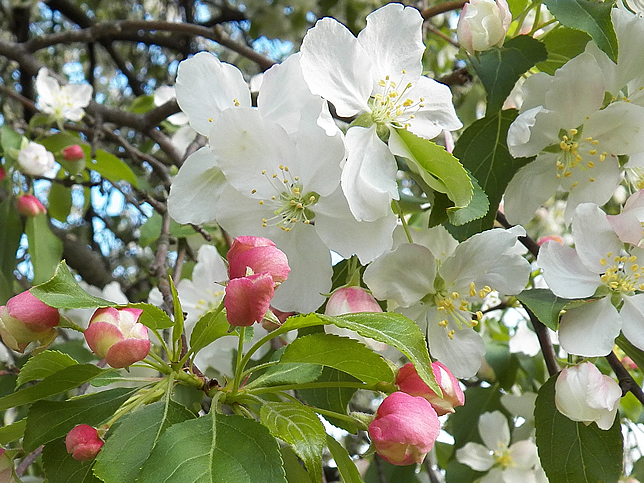After we went to the pruning class, I started really eyeing our own trees to check what needed to be done. One little tree that I view almost daily was really bugging me and I wanted to take care of it. See what I mean?
It is a cute little tree, low branched, but it has a lot of wonky growth going on. So first, some more information on pruning.
There are some other issues to consider before taking the pruning task on. Sure, we are all enthusiastic about getting out there and neatening things up in the winter, but sometimes it is best to just put the pruners away and do something else. Primarily, what I am talking about here is that you need to be aware of what is coming in terms of weather, i.e., the phenomenon of cold acclimation/de-acclimation. Woody plants go through phases of acclimating to the cold temperatures and their cold tolerance is maximal at a certain period of time depending on the species. Pruning in the late fall before the plant truly goes dormant pushes the tree or shrub to start producing more growth that is intolerant to cold and will be highly susceptible to injury and even death of the plant. Once the plant reaches its maximal cold tolerance and then we experience periods of warmer weather rather than sustained cold weather, the plant will begin to de-acclimate, or wake up. Another bout of cold weather will reactivate the acclimation process and subsequent cold protection, but the plant’s ability to repeat this becomes increasingly compromised as the season wears on. What this means is that any injury, pruning or otherwise, just before another cold snap, can cause serious damage or death. Some folks advocate backing away from the pruners anywhere from 3 days to 2 weeks before a plunge in temperatures is predicted. There’s your excuse for being a couch potato! In any case, check the weather forecast, and aim for pruning when there is less time between injury and the time when the plant can recover favorably from the injury (more on this in another post).
This little crabapple got pruned this year about 4 days before we got dumped on with 18 inches of snow and 0 degree night temps. Hopefully, this amount of time will be acceptable to it!
But look at the poor thing two years ago after a late April snowstorm, fully budded and almost all leaved out. So sometimes, you just can’t predict what the weather is going to do!
Another factor to consider, although many plants are or can be pruned now in late winter, is that there are some that it might be better to wait until after they bloom to prune. Those are the early spring bloomers such as forsythia, lilac, and early blooming spireas among others, and pruning may remove much of their glorious floral presence. On the other hand, burning bushes, ninebark, barberry, colored twig dogwood, or other plants that are primarily grown for their foliage are prime candidates for pruning before their growth starts in the spring. Note that “bleeders” or trees like maples, birches, and related species, may look unsightly and cause concern, but it usually does no harm to prune them in late winter. So, consider what you are pruning.
Although my crabapple is a spring bloomer, I want to be able to see the flowers and not a lot of vegetative growth.
And finally, let’s ask why we are pruning in the first place. If you are pruning because the plant is too big for the site, then it might be better to just remove it and replant with something more appropriate. For example, burning bushes generally want to grow to be 12-15 feet and people are forever wanting to grow them in a space 3’x3′ because they just loooove those red leaves in the fall. Well, I have news for you – there are better plants with red fall leaves for those small spaces than burning bushes! Pruning to remove dead branches, crossing branches or otherwise promote good plant health is a good reason. Pruning to force a plant to conform to an unnatural form unless you have in mind to espalier or topiary is not a good reason. Pruning to judiciously enhance a plant’s natural appearance is best and, not surprisingly, easiest to maintain. Evergreens (conifers) normally require little pruning, but different types of evergreens should be pruned according to their respective growth habits.
My little crabapple is being pruned to remove its watersprouts, suckers, and wonky branches. This closeup indicates which branches my pruners are aiming for.
So now let’s get to the pruning! (Hah, this post looks like what, when, why, and how!) A good overall view of overall pruning practices is here.
- Remove any dead, broken, injured, diseased, or insect infested branches. If you are working with diseased wood, clean your pruners or saw after each cut with bleach or rubbing alcohol. This is particularly important with highly susceptible plants such as peach trees. Now step back and look – if the plant looks good, you’re done!
- Prune out any undesirables like crossing branches, watersprouts, suckers, or too long or too low branches. Now step back and look again.
- Any further work falls in the realm of thinning, heading back for size control, or corrective pruning. Start this type of pruning when the tree is young after it has established itself in the landscape for 2 or 2 years and it will require less maintenance at maturity.
After removing just those watersprouts and suckers, the little crabapple looks pretty good.
Equipment and Techniques:
- Most everything can be handled with a good pair of pruners and and pruning saw. Keep them clean and sharp. Loppers are generally not as useful due to the wide arc of the handles and potential for inadvertent damage to surrounding branches or stems. Hedge shears, power or otherwise, are not useful except for trimming hedges and you need to be aware of the possibility of promoting twiggy outer branch growth and severe inner dieback with their use.
- Pinching – if you need to control growth, this is a good way if the growth is very young. Often, needled conifers such as pines, spruces, and firs are pinched to thicken the new growth. Do not cut this growth as it will damage the remaining needles and cause them to turn brown and unsightly.
- Thinning – this involves completely removing some branches, to the main branch or to the trunk or to the soil line. Here, the idea is to cut back properly – do not leave a stub, but also do not cut so close to the trunk that you cut through or into the branch collar. This will allow the plant to recover in the best way from the injury.
- Heading back – if you need to control size, this is a technique that involves shortening branches back to a good bud or lateral branch. Again, a proper cut should not leave a stub or cut too close to a growing bud.
From farther away, the crabapple is looking pretty handsome now.
I am anxious to see this as soon as possible! It is time for winter to be done!
How about you? Are you sooooooo ready for winter to be done? If you want more specific information or references, let me know.
